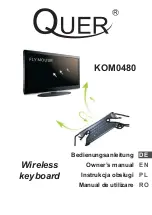
KDFX Reference
KDFX Algorithm Specifications
10-63
Page 3
Page 4
Wet/Dry
The relative amount of input signal and
fl
anger signal that is to appear in the
fi
nal effect
output mix. When set to 0%, the output is taken only from the input (dry). When set to
100%, the output is all wet. Negative values polarity invert the wet signal.
Out Gain
The overall gain or amplitude at the output of the effect.
Fdbk Level
The level of the feedback signal into the delay line. The feedback signal is taken from the
LFO1 delay tap. Negative values polarity invert the feedback signal.
Xcouple
How much of the left channel input and feedback signals are sent to the right channel
delay line and vice versa. At 50%, equal amounts from both channels are sent to both
delay lines. At 100%, the left feeds the right delay and vice versa. Xcouple has no effect if
Fdbk Level is set to 0%.
HF Damping
The amount of high frequency content of the signal sent into the delay lines. This control
determines the cutoff frequency of the one-pole (-6dB/octave) lowpass
fi
lters.
LFO Tempo
Basis for the rates of the LFOs, as referenced to a musical tempo in bpm (beats per
minute). When this parameter is set to “System”, the tempo is locked to the internal
sequencer tempo or to incoming MIDI clocks. When it is set to “System”, sources (FUNs,
LFOs, ASRs etc.) will have no effect on the Tempo parameter.
LFO Period
Sets the LFO rate based on the Tempo determined above: the number of beats
corresponding to one period of the LFO cycle. For example, if the LFO Period is set to “4”,
the LFOs will take four beats to pass through one oscillation, so the LFO rate will be 1/4th
of the Tempo setting. If it is set to “6/24” (=1/4), the LFO will oscillate four times as fast as
the Tempo. At “0”, the LFOs stop oscillating and their phase is undetermined (wherever
they stopped).
Noise Gain
The amount of noise (dB relative to full scale) to add to the input signal. In many
fl
angers,
you can hear the noise
fl
oor of the signal being
fl
anged, but in the K2661, if there is no
input signal, there is no noise
fl
oor unless it is explicitly added. [Flanger 2 only]
Noise LP
The cut-off frequency of a one pole lowpass
fi
lteracting on the noise injection signal. The
lowpass removes high frequencies from an otherwise pure white noise signal. [Flanger 2
only]
StatDlyCrs
The nominal length of the static delay tap from the delay input. The name suggests the tap
is stationary, but it can be connected to a control source such as a data slider, a ribbon, or a
StatDlyCrs
0.0 to 228.0 ms
StatDlyFin
-127 to 127 samp
Xcurs1 Crs
0.0 to 228.0 ms
Xcurs3 Crs
0.0 to 228.0 ms
Xcurs1 Fin
-127 to 127 samp
Xcurs3 Fin
-127 to 127 samp
Xcurs2 Crs
0.0 to 228.0 ms
Xcurs4 Crs
0.0 to 228.0 ms
Xcurs2 Fin
-127 to 127 samp
Xcurs4 Fin
-127 to 127 samp
Dly1 Crs
0.0 to 228.0 ms
Dly3 Crs
0.0 to 228.0 ms
Dly1 Fin
-127 to 127 samp
Dly3 Fin
-127 to 127 samp
Dly2 Crs
0.0 to 228.0 ms
Dly4 Crs
0.0 to 228.0 ms
Dly2 Fin
-127 to 127 samp
Dly4 Fin
-127 to 127 samp
Summary of Contents for K2661
Page 18: ...2 4 LFOs LFO Shapes...
Page 34: ...3 16 DSP Algorithms...
Page 54: ...5 4 MIDI Note Numbers Note Numbers for Percussion Keymaps...
Page 72: ...7 10 System Exclusive Protocol K2661 System Exclusive Implementation...
Page 82: ...9 4 Upgrading Sample Memory Choosing and Installing a SIMM for K2661 Sample Memory...
Page 334: ...10 252 KDFX Reference KDFX Algorithm Specifications...
Page 340: ...11 6 Glossary...
Page 382: ...12 42 Triple Modular Processing Alphanumeric Buttonpad Entries for DSP Functions...
Page 392: ...B 6 SysEx Control of KDFX MSB and LSB...
Page 442: ...D 20 Contemporary ROM Block Objects Controller Assignments Contemporary ROM Block...
Page 490: ...H 12 General MIDI Standard Mode Controller Assignments...
Page 492: ...I 2 Live Mode Objects Live Mode Programs...
Page 498: ...K2661 Musician s Reference Index...
Page 500: ......
















































